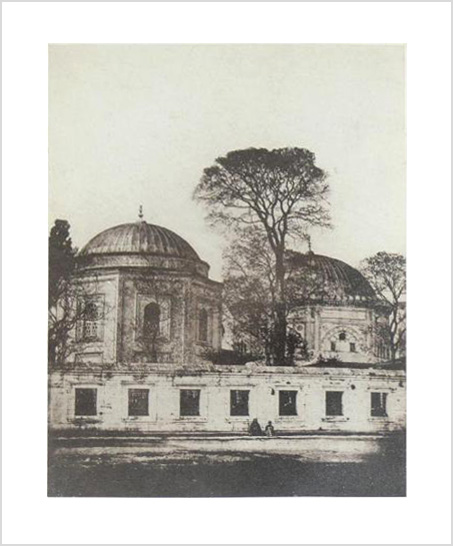
Paris : Labé, 1859.
Description : [i]-ix p., [1]-309 p., [2 l.] pl. ; ill.: 1 phot., 1 engr., in-text figs., diags. ; 19 cm.
Photograph : carbon powder print, tomb of Sultan Mahmoud in Constantinople.
Photographers : Henri Garnier & Alphonse Salmon.
Subject : Photography — Chemistry of ; manuals.
Notes :
La figure 19, qui représente la vue du tombeau du sultan Mahmoud à Constantinople, a été obtenue de cette manière dans les ateliers de MM. Salmon et Garnier. Quand le premier essai d'un procédé véritablement original donne un résultat aussi satisfaisant, son avenir est assuré.—Page 105.
Les ingénieux procédés de MM. Salmon et Garnier sont destinés à opérer une véritable révolution dans le domaine de la photographie, de la gravure et des arts céramiques. Espérons que ces habiles inventeurs réussiront à en faire, comme ils se le proposent, l'application sur une grande échelle.—Page 107.

Robiquet was the son of the celebrated chemist and member of the Paris faculty of medicine, Pierre-Jean Robiquet (1780-1840), who discovered caffeine (1821), alizirin (1826), codeine (1832), and who co-discovered the first amino acid, asparagine (1806). Robiquet was emulating his father's trajectory at the École de pharmacie and was a only few months into his appointment as professor of physics at the school when he was struck down by a gastrointestinal perforation. He was known for his early work on the aloes, also his works on picric acid, gallic fermentation, and allotropes of sulfur. Robiquet invented a device – diabétomètre – for measuring glucose in urine. He mastered photography and much of the photographic science in his textbook was personally tested in his lab at the school.
In 1858, Henri Garnier and Alphonse Salmon discovered the photochemical reaction of ferric citrate, altering its hygroscopic and solubility properties. This led to the invention of their "dusting-on" process – procédé au charbon – using a positive rather than a negative to make the exposure. Pine soot, pigment, or metal salt particles were affixed to the tacky areas of unexposed emulsion, using a tampon in conjunction with the hot breath of the photographer. The particles were then easily washed out of the exposed areas of emulsion, leaving behind the grained image. A year later, Garnier and Salmon abandoned iron salts to pursue emulsions of ammonium dichromate and sugar. The plate in Robiquet's book is one of few, or maybe the sole, published example from their workshop of their carbon powder method.
